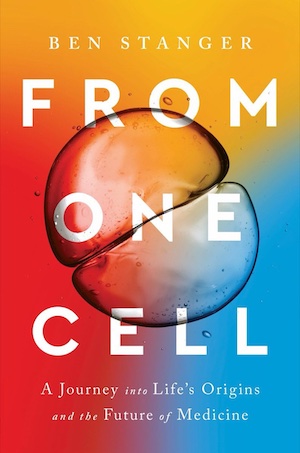By Alexander Junxiang Chen
Shortlisted for ΦBK’s 2025 Award in Science
In the beginning, there was one cell. Not light, nor Logos, but a humble zygote microscopic and silent, yet somehow embedded with the blueprint of a full human being and tasked with its gradual unfolding. If the Book of Genesis tells us how the world began with the divine Word, then Ben Stanger’s From One Cell: A Journey into Life’s Origins and the Future of Medicine offers a modern counterpoint: creation by cellular cooperation, guided not by divine fiat but by feedback, genetically-guided fate, and a fair bit of chance on occasion too. His tale of our making includes no garden, no serpent, and no rib taken from Adam, but it does, with both scientific precision and accessible eloquence, reveal how our own ribs and the rest of our bodies take shape in the embryo, cell by cell.
Stanger, a physician-scientist at the University of Pennsylvania, proves a trustworthy guide through this microscopic epic. Cells, we learn, do not simply obey genetic instructions as if they were solely automatons. They constantly adapt to their ever-changing environments, as well as negotiate and make decisions in collaboration with other cells, in the journey from zygote to a full body. What sets From One Cell, which is Stanger’s first book intended for a lay audience, apart is not just its approachable insights about developmental biology but also how it uses the personal stories inextricably linked with any kind of scientific discovery to frame and deliver them: the slightly meandering yet interweaved and fascinating chronicles of how scientists gradually uncovered the many truths about how we are made. We begin with the Greeks, as is expected, but Aristotle’s theory of “epigenesis” soon gives way to more grounded explanations from the equally grounded lenses powering the microscopes of Leeuwenhoek in the 17th century. A succession of characters then make their appearance and predictably exeunt, some surely familiar to the reader like Darwin, Lamarck, and Mendel, others perhaps less so yet equally important to the development of our understanding of, well, development: Theodor Schwann, whose name might ring the largest bell for students memorizing his eponymous nerve cell, or Wilhelm Roux and Hans Driesch, whose tense disagreements about embryology theory were to be expected given the then-nascency of the field, or the Nobel laureate Sir John Bertrand Gurdon, whose knighthood should be indication enough of the pioneering nature of his work on animal cloning.
Stanger then finally helps us arrive in the halls of modern developmental biology. With measured, unfussy prose, he walks us casually through topics that one normally only sees on the syllabus of an upper-division biology course: embryogenesis, tissue specialization, organ formation, the list goes on. A clear sense of narrative control is coupled with an unwavering focus on the book’s central question: just how does a liver cell remain a liver cell, and how does a neuron forget every other fate that could have been? Commitment is not ordained in any cell’s DNA, Stanger emphasizes, but rather arises out of the interaction and interplay between the millions of cells that make up all of us: cells talking, responding, remembering.
Stanger’s writing has a flair for elevating the microscopic into the meaningful. An anecdote about a friend’s question about the seemingly primitive state of organ regeneration in modern medicine becomes an opening for a discussion of using stem cells to essentially build new ones “from scratch.” A story about a real estate agent who remains paralyzed after suffering a spinal cord injury becomes an understated yet powerful appeal for continued investment in foundational science, for breakthroughs in human knowledge are never only represented by the number of articles published or prizes awarded, but also by the number of lives changed for the better.
Indeed, throughout his inaugural work, Stanger avoids the common sins that often afflict the genre of popular science: there is no TED Talk bombast or speech in platitudes, no flashy promises of eternal youth or life. Even in his chapters on regenerative medicine and novel cell therapies that might seem like an ultimate “cure” for cancer, he sidesteps hype. Before asking what we can do with this knowledge, he asks what we still need to understand first.
The book’s restraint is part of its charm, as is its ability to explain complex ideas without tending to jargon or over-anthropomorphizing. Of course, the book is not without its blind spots. Readers seeking a focused primer on the principles of modern developmental biology may be disappointed by the abundant use of the narrative voice. Those seeking precise predictions and detailed timelines of what is to come (Human cloning when?) may also be sent away empty-handed. And while ethical concerns around emerging therapies are mentioned, they are not explored in detail nor the author’s stance toward each of them clearly outlined. Still, these are minor points. The core of the book is sound, and its unassuming clarity is a consistent asset.
In its closing pages, From One Cell turns toward the horizon of personalized medicine, a revolution in understanding and clinical application, though one that will unfold slowly, and slower still without sustained investment in the sciences. Even so, the book’s lasting power lies not in its forecasts but in its appeal to and reframing of the familiar. Every reader was once a zygote. To revisit that process that made us human through Stanger’s lens is not just illuminating. It is unexpectedly moving.
From One Cell is not just a book about what cells do or how they do it. It is also about how we came to understand all that they are capable of and how much left we still have to figure out. For anyone interested in biology, medicine, or the mysteries still hiding in our own beginnings, it is worth reading and remembering.
Alexander Junxiang Chen (ΦBK, Harvard) is a recent graduate of Harvard University in Neuroscience and Chemistry, and a secondary emphasis in Global Health and Health Policy. He is pursuing an M.D. at the University of California San Francisco School of Medicine.




